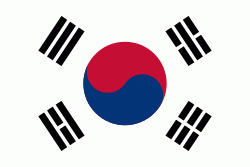Jeju-si
Jeju City (제주시; ) is the capital of the Jeju Province in South Korea and the largest city on Jeju Island. The city is served by Jeju International Airport (IATA code CJU).
Located on an island off the Korean Peninsula, Jeju has mild, warm weather during much of the year. The city is a well-known resort, with prestigious hotels and public casino facilities. In 2011, 9.9 million passengers flew between the two cities of Seoul and Jeju, making the Gimpo–Jeju route the world's busiest passenger air route. Jeju welcomes over ten million visitors every year, mainly from the South Korean mainland, Japan, and China. The population of Jeju City is 486,306 people and 205,386 households (244,153 men and 242,153 women, February 2019). The population density is 470.03 (per square km, 2015).
The area of the city has played a central role in Jeju since before recorded history. The Samseonghyeol, holes from which the three ancestors of the Jeju people are said to have come, are located in downtown Jeju City.
The city has grown quite rapidly since the 1970s. Shin Jeju, or "new Jeju", was created some decades ago, up the hill from the airport and houses many government buildings. The thatched roof buildings that were common throughout the city until the 1970s are gradually disappearing.
The city was separated from Bukjeju County in 1955. However, in 2005 Jeju Province voters approved a proposal to merge the city with Bukjeju County, also merging Seogwipo with Namjeju County to create two large cities directly administered by the province. That change was put into effect in July 2006.
In 2012 Sang-Oh Kim became mayor; he was formerly the Jeju regional president of National Agricultural Cooperative Federation.
Located on an island off the Korean Peninsula, Jeju has mild, warm weather during much of the year. The city is a well-known resort, with prestigious hotels and public casino facilities. In 2011, 9.9 million passengers flew between the two cities of Seoul and Jeju, making the Gimpo–Jeju route the world's busiest passenger air route. Jeju welcomes over ten million visitors every year, mainly from the South Korean mainland, Japan, and China. The population of Jeju City is 486,306 people and 205,386 households (244,153 men and 242,153 women, February 2019). The population density is 470.03 (per square km, 2015).
The area of the city has played a central role in Jeju since before recorded history. The Samseonghyeol, holes from which the three ancestors of the Jeju people are said to have come, are located in downtown Jeju City.
The city has grown quite rapidly since the 1970s. Shin Jeju, or "new Jeju", was created some decades ago, up the hill from the airport and houses many government buildings. The thatched roof buildings that were common throughout the city until the 1970s are gradually disappearing.
The city was separated from Bukjeju County in 1955. However, in 2005 Jeju Province voters approved a proposal to merge the city with Bukjeju County, also merging Seogwipo with Namjeju County to create two large cities directly administered by the province. That change was put into effect in July 2006.
In 2012 Sang-Oh Kim became mayor; he was formerly the Jeju regional president of National Agricultural Cooperative Federation.
Map - Jeju-si
Map
Country - South_Korea
 |
 |
| Flag of South Korea | |
The Korean Peninsula was inhabited as early as the Lower Paleolithic period. Its first kingdom was noted in Chinese records in the early 7th century BCE. Following the unification of the Three Kingdoms of Korea into Silla and Balhae in the late 7th century, Korea was ruled by the Goryeo dynasty (918–1392) and the Joseon dynasty (1392–1897). The succeeding Korean Empire (1897–1910) was annexed in 1910 into the Empire of Japan. Japanese rule ended following Japan's surrender in World War II, after which Korea was divided into two zones; a northern zone occupied by the Soviet Union and a southern zone occupied by the United States. After negotiations on reunification failed, the southern zone became the Republic of Korea in August 1948 while the northern zone became the communist Democratic People's Republic of Korea the following month.
Currency / Language
| ISO | Currency | Symbol | Significant figures |
|---|---|---|---|
| KRW | South Korean won | â‚© | 0 |
| ISO | Language |
|---|---|
| EN | English language |
| KO | Korean language |















